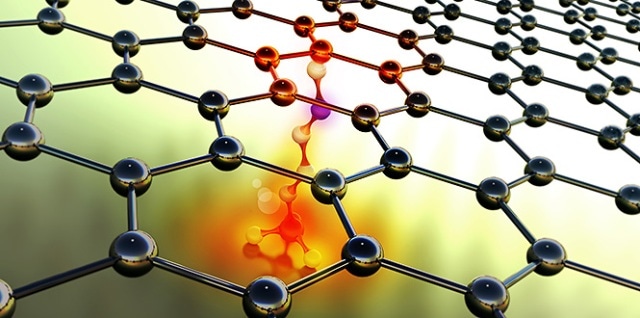May 2 2016
Heat dissipation in electronics and optoelectronics is a severe bottleneck in the further development of systems in these fields. To come to grips with this serious issue, researchers at Chalmers University of Technology have developed an efficient way of cooling electronics by using functionalized graphene nanoflakes. The results are being published in the renowned journal, Nature Communications, on 29 April.
 Functionalization mediates heat transport of graphene nanoflakes Photo source: Johan Liu, credit: Philip Krantz, Krantz Nanoart
Functionalization mediates heat transport of graphene nanoflakes Photo source: Johan Liu, credit: Philip Krantz, Krantz Nanoart
“Essentially, we have found a golden key with which to achieve efficient heat transport in electronics and other power devices by using graphene nanoflake-based film. This can open up potential uses of this kind of film in broad areas, and we are getting closer to pilot-scale production based on this discovery,” says Johan Liu, Professor of Electronics Production and Head of the Electronics Materials and Systems Laboratory at the Department of Microtechnology and Nanoscience – MC2 – at Chalmers University of Technology in Sweden.
The researchers studied the heat transfer enhancement of the film with different functionalized amino-based and azide-based silane molecules and found that the heat transfer efficiency of the film can be improved by over 76% by introducing functionalization molecules compared to a reference system without the functional layer. This is mainly because the contact resistance was drastically reduced by introducing the functionalization molecules. Meanwhile, molecular dynamic simulations and ab initio calculations reveal that the functional layer constrains the cross-plane scattering of low-frequency phonons, which in turn enhances in-plane heat-conduction of the bonded film by recovering the long flexural phonon lifetime. The results suggested potential thermal management solutions for electronic devices.
In the research, scientists studied a number of molecules that were immobilized at the interfaces and at the edge of graphene nanoflake-based sheets forming covalent bonds. They also probed interface thermal resistance by using a photo-thermal reflectance measurement technique to demonstrate an improved thermal coupling due to functionalization.
“This is the first time that such systematic research has been done. The present work is much more extensive than previously published results from several involved partners and it covers more functionalization molecules and also more extensive direct evidence of the thermal contact resistance measurement,” says Johan Liu.
Facts about the research:
The results were published in the article, “Functionalization mediates heat transport in graphene nanoflakes” in the renowned journal, Nature Communications, on 29 April.
The research was conducted in collaboration with École Centrale Paris and EM2C – CNRS in France, Lancaster University in the UK, the University of Minnesota in the USA, the Max Planck Institute for Polymer Research in Germany, Aalto University in Finland, the Russian Academy of Sciences in Russia, Shanghai University in China, and SHT Smart High Tech AB, which is a company in Sweden.